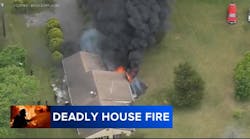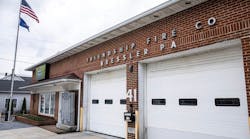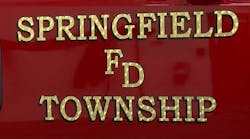NEW YORK CITY: JULY 2, 1910 — Three alarms were needed to battle a difficult fire at 112–116 Nassau Street in lower Manhattan. Sparks from a light switch apparently ignited stored rolls of film in the first-floor offices of the American Vitagraph Co. and sent waves of dense toxic smoke throughout the building, trapping as many as 150 people on the floors above. A second alarm was transmitted on arrival as firemen scrambled up the side of the building, rescuing at least seven people with scaling ladders. Amazingly, there were no fatalities, but several firemen were overcome by smoke and several others were injured by falling glass.
PATERSON, NJ: JULY 5, 1910 — An afternoon fire badly damaged the Manhattan Ribbon Co.'s five-story silk mill at River and Bridge streets. The building was closed for inventory taking, so only 25 people were inside, not the usual 200. All the employees safely escaped the fire. Although much of the stock was removed from the building, damage was estimated at more than $250,000 in destroyed silk.
NORTHPORT, NY: JULY 10, 1910 — A fire, thought to be of incendiary origin, destroyed a large barn on Eaton's Neck and five valuable horses perished in the flames. This was the second barn fire on the property in two days. When the first barn burned, those five horses were saved and relocated into the doomed structure. Several carriages and all their harnesses were also destroyed, but several automobiles were rolled to safety.
CAMPBELLTON, NEW BRUNSWICK: JULY 11, 1910 — A fire started when a spark from a mill burner ignited a pile of shingles at the Richards Co. cedar shingle mill. Burning shingles were blown all over town by a strong wind, igniting the railway station, freight sheds, telegraph offices, several churches, several hotels, a furniture store, the opera house and many dwellings. Nearly everything in the town was destroyed. When the smoke cleared, only seven buildings out of 1,000 were left standing. Two lives were lost, one a dentist using his car to shuttle people to safety died when he was caught in a gasoline explosion and an infant suffocated in the heavy smoke. Five thousand people were left homeless. The fire also spread to the nearby village of Richardsville, where it consumed another 75 buildings.
CHICAGO, IL: JULY 20, 1910 — A 12-year-old boy admitted setting seven separate building fires and causing several thousand dollars in damage. The boy said he set the buildings on fire to get even with a fireman who chased him away from an engine house.
BRIDGETOWN, BARBADOS: JULY 20, 1910 — Around noontime, a fire, believed to be set by an arsonist, started in a barrel-making company and was burning for a considerable time before it was discovered. Flames spread to the adjacent district, called Golden Square, where many small houses owned by the poor burned quickly. Spectators and workers joined the Fire Brigade members who were fighting to bring the flames under control when a huge warehouse in Cavan's Lane was also discovered ablaze. Unfortunately, there was now much more fire than equipment to fight it. Water could not be brought to bear on the new fire, and soon the building and contents were destroyed and the blaze continued spreading.
HEINEMANN, WI: JULY 21, 1910 — A gigantic forest fire was closing in on the town, leaving the 100 inhabitants stranded. H.H. Heinemann took a train from St. Paul without waiting for permission from the railroad and ran the train back and forth until everyone in town was safe. He was also able to save 15 freight cars left on a siding and pulled them to safety. The people and the freight cars were taken to nearby Gleason as the little town they left burned to the ground. The fire to this point had burned an estimated 10 million feet of standing timber.
CHICAGO, IL: JULY 24, 1910 — The city faced three serious fires during the day when flames swept through a half-block of homes in the Lakeview section, wiping out 20 buildings. The Cragin grain elevator of the Northwestern Malta and Grain Co. burned to the ground and the plant of the Ogren Brewing Co. was destroyed by fire. A woman was seriously burned at the Lakeview fire and two firemen were seriously injured at the grain elevator fire.
PAUL HASHAGEN, a Firehouse® contributing editor, is a retired FDNY firefighter who was assigned to Rescue 1 in Manhattan. He is also an ex-chief of the Freeport, NY, Fire Department. Hashagen is the author of the FDNY: The Bravest, An Illustrated History 1865–2002, the official history of the New York City Fire Department, and other fire service books. His latest novel, Fire of God, is available at dmcfirebooks.com.





